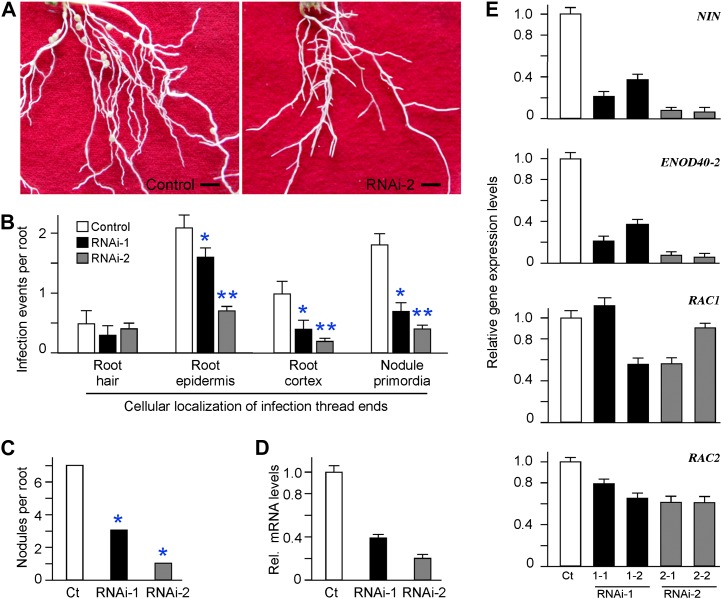Figure 6.
Effects of ROP6 RNAi expression on rhizobial infection and nodulation in L. japonicus. A, Images representing the hairy root systems expressing the empty vector (control) or ROP6 RNAi-2. Photographs were taken 3 weeks after inoculation with M. loti MAFF303099, and plants were grown in the absence of nitrogen fertilizer. Bars = 5 mm. B, Frequencies of infection events in transgenic hairy roots expressing empty vector p1302G (control) or ROP6 RNAi-1 and RNAi-2. Transgenic hairy roots were inoculated with M. loti strain MAFF303099 expressing the lacZ β-galactosidase. Nine days post rhizobial inoculation, the roots were stained with X-gal and the cellular distribution of infection threads was recorded with a microscope. Ten independent transgenic hairy root systems for each construct were generated. Four roots between 4 and 6 cm in length were chosen to represent each root system. Asterisks indicate statistical differences from the value of the control at * P < 0.01 and ** P < 0.001. C, Nodule numbers of transgenic hairy roots expressing the empty vector (control [Ct]) or ROP6 RNAi-1 and RNAi-2. Nodulation phenotypes were examined 3 weeks after inoculation with M. loti MAFF303099. D, Knockdown of ROP6 transcripts in transgenic hairy roots expressing ROP6 RNAi-1 and RNAi-2. The expression levels of ROP6 mRNA were estimated by real-time RT-PCR. The ROP6 expression values for RNAi-1 and RNAi-2 roots were compared with that of the control hairy roots expressing empty vector p1302G (control [Ct]), and relative mRNA levels are shown. E, Real-time PCR analysis of the expression of nodulation marker genes and ROP6 homologs in transgenic hairy roots expressing ROP6 RNAi. Total RNA was isolated from two representative root systems for each RNAi construct and used for real-time PCR amplification. Note that the expression of NIN and ENOD40-2, serving as the marker genes for rhizobial infection and early nodulation, was down-regulated by ROP6 RNAi expression. The expression of RAC1 and RAC2, two ROP6 homolog genes in L. japonicus, was not affected by ROP6 RNAi expression. [See online article for color version of this figure.]

